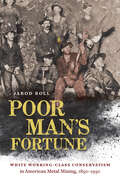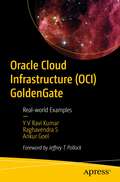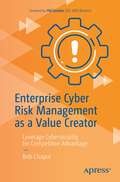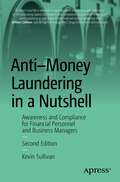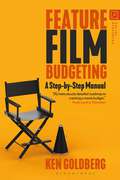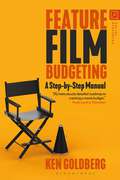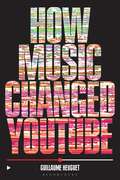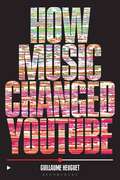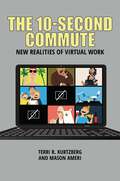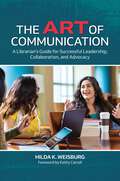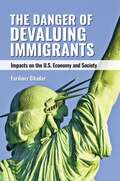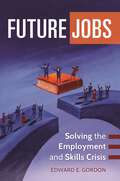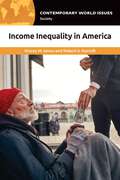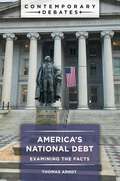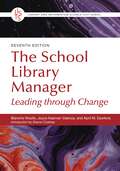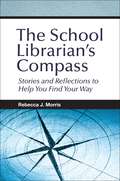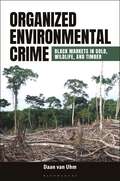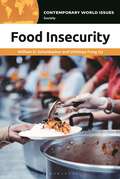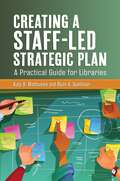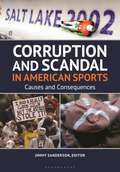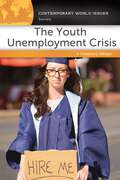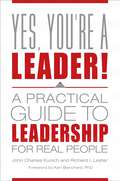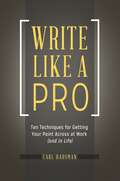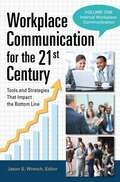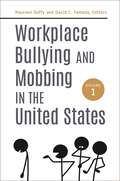- Table View
- List View
Poor Man's Fortune: White Working-Class Conservatism in American Metal Mining, 1850–1950
by Jarod RollWhite working-class conservatives have played a decisive role in American history, particularly in their opposition to social justice movements, radical critiques of capitalism, and government help for the poor and sick. While this pattern is largely seen as a post-1960s development, Poor Man's Fortune tells a different story, excavating the long history of white working-class conservatism in the century from the Civil War to World War II. With a close study of metal miners in the Tri-State district of Kansas, Missouri, and Oklahoma, Jarod Roll reveals why successive generations of white, native-born men willingly and repeatedly opposed labor unions and government-led health and safety reforms, even during the New Deal. With painstaking research, Roll shows how the miners' choices reflected a deep-seated, durable belief that hard-working American white men could prosper under capitalism, and exposes the grim costs of this view for these men and their communities, for organized labor, and for political movements seeking a more just and secure society. Roll's story shows how American inequalities are in part the result of a white working-class conservative tradition driven by grassroots assertions of racial, gendered, and national privilege.
Oracle Cloud Infrastructure (OCI) GoldenGate: Real-world Examples
by Y V Ravi Kumar Raghavendra S Ankur GoelThis book focuses on the utilization of GoldenGate Services (GGS) in conjunction with a microservices architecture on the Oracle cloud (OCI), primarily for data migration and integration across various data sources and targets.The book begins with a practical example of utilizing GGS on a Marketplace VM, progressively advancing to in-depth discussions on implementing GoldenGate as a Service on OCI. The book offers illustrative guides for data replication between RDBMSs (such as Oracle, Postgres, and big data targets such as Kafka). Additionally, it explores monitoring techniques using Enterprise Manager and Grafana dashboards. A comparative analysis is presented between traditional VM-based GoldenGate installations and the OCI service model. Special attention is given to Zero Downtime Migration (ZDM) and leveraging GGS for database migration from on-premises to OCI. Some chapters address multi-cloud replication using OCI GGS and include real-life case studies.By the end of this book you will have gained comprehensive insights into the architectural design of GoldenGate Services and will be adept at replicating data using GGS, enabling you to replicate setups in your own environments.What You Will LearnSet up GoldenGate Services for high availability (HA), disaster recovery (DR), migration of data to cloud, and moving data into the data lake or lakehousePerform logical migration of data to the cloud using the ZDM tool (ZDM uses GoldenGate internally).Replicate data to big data targetsMonitor GGS using Enterprise Manager and GrafanaReplicate data in a multi-cloud environment Who This Book Is ForOracle database administrators who want to replicate data or use Oracle GoldenGate Services for migration and setup of high availability (HA) and disaster recovery (DR); and data engineers who want tobuild the data warehouse, data lake, data lakehouse to push data in near real-time
Enterprise Cyber Risk Management as a Value Creator: Leverage Cybersecurity for Competitive Advantage
by Bob ChaputThis book will help you learn the importance of organizations treating enterprise cyber risk management (ECRM) as a value creator, a business enabler, and a mechanism to create a competitive advantage. Organizations began to see the real value of information and information technology in the mid-1980s. Forty years later, it’s time to leverage your ECRM program and cybersecurity strategy in the same way. The main topics covered include the case for action with specific coverage on the topic of cybersecurity as a value creator, including how the courts, legislators, and regulators are raising the bar for C-suite executives and board members. The book covers how the board’s three primary responsibilities (talent management, strategy, and risk management) intersect with their ECRM responsibilities.ECRM was once solely focused on managing the downside of risk by defending the organization from adversarial, accidental, structural, and environmental threat sources. Author Bob Chaput presents the view that we must focus equally on managing the upside of cyber strengths to increase customer trust and brand loyalty, improving social responsibility, driving revenue growth, lowering the cost of capital, attracting higher quality investments, creating competitive advantage, attracting and retaining talent, and facilitating M&A work. He focuses on the C-suite and board role in the first part and provides guidance on their roles and responsibilities, the most important decision about ECRM they must facilitate, and how to think differently about ECRM funding. You will learn how to the pivot from cost-center thinking to value-center thinking.Having built the case for action, in the second part, the book details the steps that organizations must take to develop and document their ECRM program and cybersecurity strategy. The book first covers how ECRM must be integrated into business strategy. The remainder of that part presents a sample table of contents for an ECRM Program and Cybersecurity Strategy document and works through each section to facilitate development of your own program and strategy. With all the content and ideas presented, you will be able to establish, implement, and mature your program and strategy.What You Will LearnRead new information and treat ECRM and cybersecurity as a value creatorReceive updates on legal cases, legislative actions, and regulations that are raising the stakes for organizations, their C-suites, and boardsThink differently about funding ECRM and cybersecurity initiativesUnderstand the most critical ECRM decision that boards must facilitate in their organizationsUse practical, tangible, actionable content to develop and document your ECRM program and cybersecurity strategy“This book should be mandatory reading for C-suite executives and board members. It shows you how to move from viewing cybersecurity as a risk to avoid, and a cost center that does not add value and is overhead, to seeing cybersecurity as an enabler and part of your core strategy to transform your business and earn customer and stakeholder trust.” —Paul Connelly, First CISO at the White House and HCA Healthcare Who This Book Is ForThe primary audience includes Chief Information Security Officers, Chief Risk Officers, and Chief Compliance Officers. The secondary audience includes C-suite executives and board members. The tertiary audience includes any stakeholder responsible for privacy, security, compliance, and cyber risk management or students of these topics.
Anti-Money Laundering in a Nutshell: Awareness and Compliance for Financial Personnel and Business Managers
by Kevin SullivanAnti–Money Laundering in a Nutshell is a concise, accessible, and practical guide to compliance with anti–money laundering law for financial professionals, corporate investigators, business managers, and all personnel of financial institutions who are required, under penalty of hefty fines, to get anti–money laundering training. This new edition of Anti-Money Laundering will update the topics discussed, and introduce the changes and updates including information on the AMLA Act of 2020, new EU standards and directives, anti-money laundering on digital currencies and more.Money laundering is endemic. As much as 5 percent of global GDP ($3.6 trillion) is laundered by criminals each year. It’s no wonder that every financial institution in the United States—including banks, credit card companies, insurers, securities brokerages, private funds, and money service businesses—must comply with complex examination, training, and reporting requirements mandated by a welter of federal anti–money laundering (AML) laws. Ignorance of crime is no excuse before the law. Financial institutions and businesses that unknowingly serve as conduits for money laundering are no less liable to prosecution and fines than those that condone or abet it.In Anti–Money Laundering in a Nutshell: Awareness and Compliance for Financial Personnel and Business Managers, Kevin Sullivan draws on a distinguished career as an AML agent and consultant to teach personnel in financial institutions what money laundering is, who does it, how they do it, how to prevent it, how to detect it, and how to report it in compliance with federal law. He traces the dynamic interplay among employees, regulatory examiners, compliance officers, fraud and forensic accountants and technologists, criminal investigators, and prosecutors in following up on reports, catching launderers, and protecting the integrity and reputations of financial institutions and businesses. In particular, corporate investigators will gain rich insights winnowed from the author's experiences as a New York State and federal investigator.
Feature Film Budgeting: A Step-by-Step Manual
by Ken GoldbergFeature Film Budgeting: A Step-by-Step Manual is a step-by-step guide to film budgeting in the $600k to $6.5 Million range. Be it the film student, Line Producer, 1st Assistant Director, or script writer, all will benefit from the easy-to-follow steps on how to create a film budget. This book walks the reader through how to:- find current and future salary rates for every Hollywood Guild- determine Prep and Wrap periods for all crew members- navigate the Guild contracts for easy understanding- analyze salary rates and how they were arrived at- simplify the application of fringe rates (tax percentages). Additionally, sample budgets are presented to reinforce knowledge gained in each chapter through a comprehensive breakdown. Notably, this manual covers films budgeted in the $600,000 to $6.5 Million range. This allows the reader to focus and excel at those budget levels before moving on to higher budget levels.
Feature Film Budgeting: A Step-by-Step Manual
by Ken GoldbergFeature Film Budgeting: A Step-by-Step Manual is a step-by-step guide to film budgeting in the $600k to $6.5 Million range. Be it the film student, Line Producer, 1st Assistant Director, or script writer, all will benefit from the easy-to-follow steps on how to create a film budget. This book walks the reader through how to:- find current and future salary rates for every Hollywood Guild- determine Prep and Wrap periods for all crew members- navigate the Guild contracts for easy understanding- analyze salary rates and how they were arrived at- simplify the application of fringe rates (tax percentages). Additionally, sample budgets are presented to reinforce knowledge gained in each chapter through a comprehensive breakdown. Notably, this manual covers films budgeted in the $600,000 to $6.5 Million range. This allows the reader to focus and excel at those budget levels before moving on to higher budget levels.
How Music Changed YouTube
by Dr. Guillaume HeuguetHow do digital technologies transform music? The answer depends on the lens of one's analysis: creation, promotion, or the experience of the listener. How Music Changed YouTube shows that the reverse question – How does music transform digital technologies? – is also worth exploring: through reliance on sound recording and music, internet technologies and media are manufactured, transformed, and come to dominate.Guillaume Heuguet's study situates YouTube in relation to both the internet platform and music industries by unpacking the cultural and technological forms embedded within and observing the practices and values associated with it, from the art of collecting to the accelerated circulation of samples and remixes. Heuguet's documentary and genealogical work relies on YouTube's traces in internet archives, its successive interfaces, the blogs of its teams, and a few emblematic channels and videos. Particular attention is paid to the tensions between the promises associated with music algorithms - recommendation system, copyright control, view calculation - and the reality of their operation from a technical and cultural point of view. How Music Changed YouTube shows how, far from responding to an immediate need, YouTube's editorial and economic model developed over time, how the various fans, artists, labels, lawyers and legislators shaped the site, and how these factors affected its rise as a global media force in the early 21st century.
How Music Changed YouTube
by Dr. Guillaume HeuguetHow do digital technologies transform music? The answer depends on the lens of one's analysis: creation, promotion, or the experience of the listener. How Music Changed YouTube shows that the reverse question – How does music transform digital technologies? – is also worth exploring: through reliance on sound recording and music, internet technologies and media are manufactured, transformed, and come to dominate.Guillaume Heuguet's study situates YouTube in relation to both the internet platform and music industries by unpacking the cultural and technological forms embedded within and observing the practices and values associated with it, from the art of collecting to the accelerated circulation of samples and remixes. Heuguet's documentary and genealogical work relies on YouTube's traces in internet archives, its successive interfaces, the blogs of its teams, and a few emblematic channels and videos. Particular attention is paid to the tensions between the promises associated with music algorithms - recommendation system, copyright control, view calculation - and the reality of their operation from a technical and cultural point of view. How Music Changed YouTube shows how, far from responding to an immediate need, YouTube's editorial and economic model developed over time, how the various fans, artists, labels, lawyers and legislators shaped the site, and how these factors affected its rise as a global media force in the early 21st century.
The 10-Second Commute: New Realities of Virtual Work
by Terri R. Kurtzberg Mason AmeriVirtual work, which was steadily on the rise even before the pandemic, is explored in this timely book that describes the impact of technology on our work experiences, ranging from the individual psychological level to the broad societal implications.Widespread remote work is now possible, but it comes with its share of frustrations. Virtual work has changed our lives in ways big and small, from trying to balance our time to what we wear and where we sit and from how we communicate to where we should look during a videoconference. It's also fundamentally changed what kinds of jobs we can now do.Grounded in research and including lively personal anecdotes, The 10-Second Commute provides a thoughtful and comprehensive scan of the nature of virtual work. The authors, both researchers in management and technology, explore the current questions of our virtual lives, such as: Why Zoom instead of Skype? Why are emojis so useful? Why is videoconferencing so exhausting? How does diversity at work both help and hinder productivity? Virtual work is more than just work-it permeates our whole lives, and it will continue to do so as hybrid work arrangements become the new normal. Helping readers better understand the virtual work experience, this book will engage and inform everyone who is still trying to make it work.
The Art of Communication: A Librarian's Guide for Successful Leadership, Collaboration, and Advocacy
by Hilda K. WeisburgLibrarians will learn communication skills that help them develop as leaders, build community, and advocate for their libraries.Librarians understand the importance of making the value of the library known to stakeholders. In this informative and conversational book, Hilda K. Weisburg gradually builds librarians' communication skills, which are intrinsic to the success of library programs and services. Being able to effectively communicate as a sender and receiver of messages is a vital leadership skill, and librarians must master all the multi-faceted ways people exchange information in order to grow as leaders.Throughout the book, librarians will learn communication basics and the obstacles that interfere with successful communication. The chapters in part one detail the three components of communication; part two prepares librarians to cope with difficult communications; and part three gives librarians further techniques to ensure their messages are cohesive and strategic as they reach out to stakeholders.The book's goal is for librarians to feel confident about using their newly learned communication skills for advocacy. As their value to the library community grows, they will be able to strategically use the relationships their communications have built to create positive change.
The Danger of Devaluing Immigrants: Impacts on the U.S. Economy and Society
by Fariborz GhadarDespite deep divisions on the issue of immigration, this book shows that immigration promotes economic innovation, expands the job market, and contributes to diversity and creativity in the United States.Immigration, as a conduit for bringing new talent, ideas, and inventions into the United States, is essential to the success and vitality of our economy and society. In this timely book, researched and written by the Immigration Book Project Team at Penn State University, immigration is approached from historical, economic, business, and sociological perspectives in order to argue that treatment of immigrants must reflect and applaud their critical roles in supporting and leading the economic, social, cultural, and political institutions of civil society.Approaching immigration as both a socioeconomic phenomenon and a matter of public policy, The Danger of Devaluing Immigrants offers demographics and statistics on workforce participation and job creation along with stories of individual immigrantS&Rsquo; contributions to the economy and society. It supports the idea that, when immigration is challenged in the political sphere, we must not lose sight of the valuable contributions that immigrants have made-and will continue to make-to our democracy.
Future Jobs: Solving the Employment and Skills Crisis
by Edward E. GordonA pervasive disconnect exists between the job/career culture and the present economic reality in America. This book offers powerful strategies for stemming the employment crisis and proposes comprehensive solutions for businesses, government, and job seekers alike.America's low unemployment rate overshadows the fact that more that 20 million Americans are still unemployed. Moreover, more than eight million jobs are vacant because employers cannot find qualified candidates. It is projected that if this imbalance between available positions and skills is not quickly addressed, more than 14 million jobs will be vacant by 2020, and that many more people out of work.In Future Jobs, historical economist Edward E. Gordon explains how increasingly complex technologies, global demographic shifts, and outdated education-to-employment systems are converging and may imminently cause a labor-market crisis. How can we ensure that enough people possess the skills necessary to holding the jobs of today and tomorrow? This book points to a solution gaining traction across the United States: Regional Talent Innovation Networks (RETAINs), alliances of businesses, educators, government agencies, and nonprofit organizations that successfully bridge the talent gap. Additionally, it provides information on the most promising jobs and careers of the next decade for early-career job seekers and for workers who are looking to change career paths.
Income Inequality in America: A Reference Handbook (Contemporary World Issues)
by Stacey M. Jones Robert S. RycroftThis book provides a one-stop resource for understanding the full dimensions of income inequality in the United States, including chief socioeconomic drivers of inequality and proposals to reduce the widening gap between rich and poor in America.Carefully researched and scrupulously nonpartisan, this resource examines the history and current state of income inequality in the United States, with a particular focus on key issues, events, and political/economic philosophies relevant to the enduring divide between rich and poor in America. One of the most valuable aspects of the book is that it surveys the complex history of income inequality in an easy-to-understand fashion that helps readers identify and assess the ways in which income inequality shapes many aspects of modern American society. The book is even-handed in its treatment of the academic and policy debates over the causes, consequences, and appropriate response to today's growing inequality.In addition, this resource provides insights into the financial underpinnings of debt and wealth and capitalism and how all of those factors perpetuate themselves. It also examines problems and challenges related to child care, education, transportation, housing, and saving for retirement that hamper so many poor people in their efforts to lift their households out of poverty.
America's National Debt: Examining the Facts (Contemporary Debates)
by Thomas ArndtThis vital resource is devoted to providing nonpartisan, objective analysis of the national debt, including leading drivers of the debt, the budgetary process, and claims and counter-claims about national debt benefits and drawbacks.This indispensable resource provides readers with a clear and unbiased understanding of the national debt and its relationship to the U.S. economic system. The book addresses the foundations and major elements of America's budgetary process, details how government taxing and spending priorities impact the nation's debt, explains the difference between deficits and debt, and summarizes dominant conservative and liberal economic perspectives on the national debt and related fiscal issues.Utilizing authoritative resources and accessible, lay-friendly terminology, this book punctures popular myths and misconceptions about the national debt. But it also shines a light on the numerous economic, social, and political drivers of our national conversation about the debt—and the ways in which the national debt is likely to influence the lives of future generations of Americans. At a time when American political discourse often descends into fact-free zones of wishful thinking and deceptive claims, this book provides information for readers to truly understand the national debt.
The School Library Manager: Leading through Change (Library and Information Science Text Series)
by Blanche Woolls Joyce Kasman Valenza April M. DawkinsThe seventh edition of this comprehensive school library management text expands upon the role of the school librarian, especially in the ever-growing digital realm, and highlights the importance of school librarian leadership and outreach.In an era of budget cuts, reduced staffing, and a global pandemic, it's more important than ever for new LIS professionals and established school librarians and administrators to demonstrate the value of school libraries to decision makers.This revised and updated edition of a classic text adds two well-known authors to help lead readers through the many essential management tasks and skills required to administer the successful school library program. It emphasizes the importance of the school librarian in providing digital access to information for teachers and students, describes how facilities are being modified to accommodate new resources and programming, and offers new ways to use AASL standards to evaluate programs.All chapters are updated, and the text addresses such timely subjects as providing information resources when students, teachers, and librarians are interacting online. A new chapter highlights the importance of the school librarian's leadership in schools, districts, and communities. This invaluable textbook teaches practical skills for school library management and offers inspiration and guidance for growing LIS careers.
The School Librarian's Compass: Stories and Reflections to Help You Find Your Way
by Rebecca J. MorrisBy working through these cases and the accompanying learning exercises, both pre-service and practicing school librarians will strengthen their readiness, expand their perspectives, and build confidence for solving problems and making informed, thoughtful decisions in their school libraries.In their preparation for school librarianship, library students learn foundational ideals and observe best practices that center and guide their work. However, discussions of aspirational versions of school librarianship often leave out sufficient practice in managing the many challenges and decisions school librarians face on the job. In this book, veteran educator Rebecca J. Morris uses stories of day-to-day librarianship to empower school librarians as they navigate and manage the complex interactions, decisions, and opportunities of their work.The book's alignment with the AASL/CAEP standards makes it helpful to school library educators planning curriculum, syllabi, and course activities. Perfect for reading or study groups, graduate classes, and professional development, these stories invite reflection and lively conversation.
Organized Environmental Crime: Black Markets in Gold, Wildlife, and Timber
by Daan van UhmDeveloping an innovative approach to understanding how organized crime groups diversify into the illegal trade in natural resources, this book looks at the convergence between environmental crime and other serious crimes.In Organized Environmental Crime, Daan van Uhm breaks new ground by rejecting the classic image of organized crime as specializing in one kind of criminal activity. Instead, he develops an innovative approach to understanding how organized crime groups diversify into the illegal trade in natural resources by looking at the convergence between environmental crime and other serious crimes. Personal stories from informants directly involved in organized crime networks offer unique insights into the black markets in gold, wildlife, and timber in three environmental crime hotspots: the Darién Gap, a remote swath of jungle on the Colombia-Panama border in Latin America; the Golden Triangle, a notorious opium epicenter in Southeast Asia; and the eastern edge of the Congo basin, an important conflict area in Central Africa. The proliferation of organized environmental crime exacerbates the global destruction of ancient rainforests; the mass extinction of species; and the pollution of the atmosphere, land, and water, negatively affecting planet Earth. By uncovering its incentives, features, and harms, this book is crucial to understanding organized environmental crime in a rapidly changing world.
Food Insecurity: A Reference Handbook (Contemporary World Issues)
by William D. Schanbacher Whitney Fung UyThis comprehensive and authoritative one-stop resource examines the issue of food insecurity in the United States, including the various economic, social, political, and cultural factors that drive the problem.Social welfare agencies, schools, food banks, and other organizations have all put forth efforts to combat food insecurity, but it remains a serious risk for millions of poor Americans today. Food Insecurity: A Reference Handbook examines the reasons why food insecurity remains such a longstanding problem in American society.Beginning with a history of food insecurity from the country's origins to the present day, the book also delves into the problems and controversies related to food insecurity, such as urban food deserts, substance abuse impacts, nutrition education, and income inequality. One of the most valuable aspects of the book is that it surveys the history of food insecurity in a manner that helps the reader identify key issues in an easy-to-understand fashion. The book's Perspectives chapter presents a broad range of voices on various facets of food insecurity, providing crucial, diverse perspectives to round out the coverage and expertise of the authors.
Creating a Staff-Led Strategic Plan: A Practical Guide for Libraries
by Katy B. Mathuews Ryan A. SpellmanTaking a staff-led approach, this book helps libraries of all types create their own meaningful and authentic strategic plans while demystifying a process that can bring many benefits to the organization.With dwindling budgets to pay for consultants and a growing interest in collaboration across the organization, libraries are increasingly taking a do-it-yourself approach to strategic planning.This book takes a step-by-step approach to grassroots strategic planning for libraries of all types. The authors, who led a successful strategic planning process at their own library, provide practical advice and detailed information to guide library personnel through their own process. Topics include aligning with institutional and community values, creating vision and mission statements, researching stakeholder needs, conducting environmental scans, collaborative drafting of the plan, communication strategies, and implementation and assessment of the plan. Each chapter helps librarians create a strategic plan for a broad spectrum of libraries, including K–12, post-secondary, public, and special libraries. A unique feature of the book is its emphasis on the ways in which different library types can collaborate to meet shared goals.This book is a one-stop-shop, providing everything library staff will need to create a strategic plan without searching for additional sources.
Corruption and Scandal in American Sports: Causes and Consequences
by Jimmy SandersonScandals about cheating and corruption have dogged amateur and professional sports in the United States since the nation's earliest days. This work examines the most infamous and consequential of these controversies and scandals both on and off the field.Authoritative Individual essays tackle notorious events in popular American sports ranging from the 1919 Black Sox scandal to revelations of sign stealing by the Houston Astros throughout their 2020 championship season, with stops in between to survey horrific sex abuse scandals at Penn State, Baylor, and Michigan State; steroid and drug scandals that brought down once-admired athletes like Mark McGwire and Lance Armstrong; and cheating/betting controversies that tainted individual players (Pete Rose), teams (Boston College, New England Patriots), and entire leagues (including the Little League World Series in 2001). But this work does more than just recount these events; it will also examine the cultural and economic pressures and forces that contributed to these events, as well as the lessons learned and steps taken (if any) to enact reform and help the sport recover.
The Youth Unemployment Crisis: A Reference Handbook (Contemporary World Issues)
by Christina G. VillegasSurveys the history of youth unemployment and identifies key issues underlying the current crisis.The Youth Unemployment Crisis: A Reference Handbook examines the recent phenomenon in the United States wherein young workers ages 16 to 24 are unemployed or disconnected from the labor force at disproportionate rates. It describes in detail what led to the crisis, who it affects, and what can be and is being done about it. The book opens with a chapter that addresses the nature and scope of the crisis, which is followed by a discussion of the inherent problems, controversies, and possible solutions. It includes essays from a diverse range of contributors, providing useful perspectives to round out the author's expertise, as well as a collection of data and documents; an overview of important people, organizations, and resources relating to the crisis; a chronology listing important events in the youth unemployment timeline; and a glossary of key terms.
Yes, You're a Leader!: A Practical Guide to Leadership for Real People
by John Charles Kunich Richard I. LesterOffering an array of fresh innovations to remedy the most daunting leadership challenges of today's complex and rapidly evolving world, this practical how-to guide is for anyone who has ever had qualms about his or her lack of leadership experience or imagined limitations.Everyone in a leadership or management role wants a quick and effective solution to the most severe problems. This book enables even a novice to proactively work through the largest challenges. Rather than providing clichés or superficial advice, the authors leverage the most impactful examples of key elements of leadership in a practical way that readers can translate to their own situations, no matter if they are in charge of a for-profit, not-for-profit, educational, religious, family, or social organization. The questions for analysis in each chapter specifically guide readers as they apply the material to their own experiences and challenges, making the insights pragmatic, relevant, and immediately useful.The book presents innovative tools and techniques, such as the use of Pascal's Wager to make momentous decisions despite gaps in relevant data and an uncertain future, as well as a way to reduce or eliminate the career-ending threat of any reader's most severe "Achilles' heel" vulnerabilities. The time management chapter supplies dozens of pragmatic ideas to do more in less time—and do it better; the chapter on "Quicksand Quadrants" enables any leader to quickly assess the optimal mix of approaches in any situation. It all adds up to an essential—and user-friendly—manual for every leader at every level.
Write Like a Pro: Ten Techniques for Getting Your Point Across at Work (and in Life)
by Carl HausmanFor those looking to become great business writers, this practical guide supplies clear instruction and examples of how to organize thoughts into written form, impart information with pinpoint accuracy, persuade, and hold the reader's interest: in short, to use language to get what you want.In today's business world, writers need to be prepared and comfortable with various forms of writing: reports, blogs, social media, white papers. Written by an established expert on writing and communication, journalism professor Carl D. Hausman, Write Like a Pro: Ten Techniques for Getting Your Point Across at Work (and in Life) can make you a better writer, regardless of your experience and current skill level; and will teach you how to vastly improve your written communication through a straightforward, easy-to-follow method.This book doesn't just cover the essential "mechanics" of good writing; it focuses on developing the more subtle skills of infusing your writing with eloquence, power, accuracy, and persuasiveness—and it shows readers how to achieve those qualities with no-nonsense advice. The information is highly accessible, sometimes amusing, and replete with memorable examples that demonstrate what works and teaches a strategy for solving any writing problem. It is essential reading for anyone who wants to write effectively, in any form, from emails to complaint letters to social media.
Workplace Communication for the 21st Century [2 volumes]: Tools and Strategies That Impact the Bottom Line [2 volumes]
by Jason S. WrenchWritten in clear, non-technical language, this book explains how employees and employers can maximize internal and external organizational communication—for both personal benefit and to the entity as a whole.Workplace Communication for the 21st Century: Tools and Strategies That Impact the Bottom Line explains and simplifies what organizational communication scholars have learned, presenting this knowledge so that it can be easily applied to generate tangible benefits to employees and employers as they face everyday challenges in the real world.This two-volume work discusses internal organizational and external organizational communication separately, first explaining how communication functions within the confines of a modern organization, then addressing how organizations interact with various stakeholders, such as customers, clients, and regulatory agencies. The expert contributors provide a thorough and insightful view on organizational communication and supply a range of strategies that will be useful to practitioners and academics alike.
Workplace Bullying and Mobbing in the United States [2 volumes]: [2 volumes]
by Maureen Duffy and David C. YamadaOffering multidisciplinary research and analysis on workplace bullying and mobbing, this two-volume set explores the prevalence of these behaviors in sectors ranging from K–12 education to corporate environments and exposes their effects on both individuals and organizations.Workplace Bullying and Mobbing in the United States provides a comprehensive overview of the nature and scope of the problem of workplace bullying and mobbing. By tapping the knowledge of a breadth of subject experts and interpreting contemporary survey data, this resource examines the impact of bullying and mobbing on targets; identifies what constitutes effective prevention and intervention; surveys the legal landscape for addressing the problem, from both American and (for multinational employers) transnational perspectives; and provides an analysis of key employment sectors with practical recommendations for prevention and amelioration of these behaviors.The contributors to this outstanding work include researchers, practitioners, and policy and subject-matter experts who are widely recognized as authorities on workplace bullying and mobbing, including Drs. Gary and Ruth Namie, cofounders of the U.S. workplace anti-bullying movement; Drs. Maureen Duffy and Len Sperry, internationally recognized authorities on workplace mobbing; and professor David Yamada, leading expert on the legal aspects of workplace bullying. The set's content will be of particular value to scholars and practitioners in disciplines that overlap with American labor and employee relations, industrial/organizational psychology and mental health, and law and conflict resolution.
